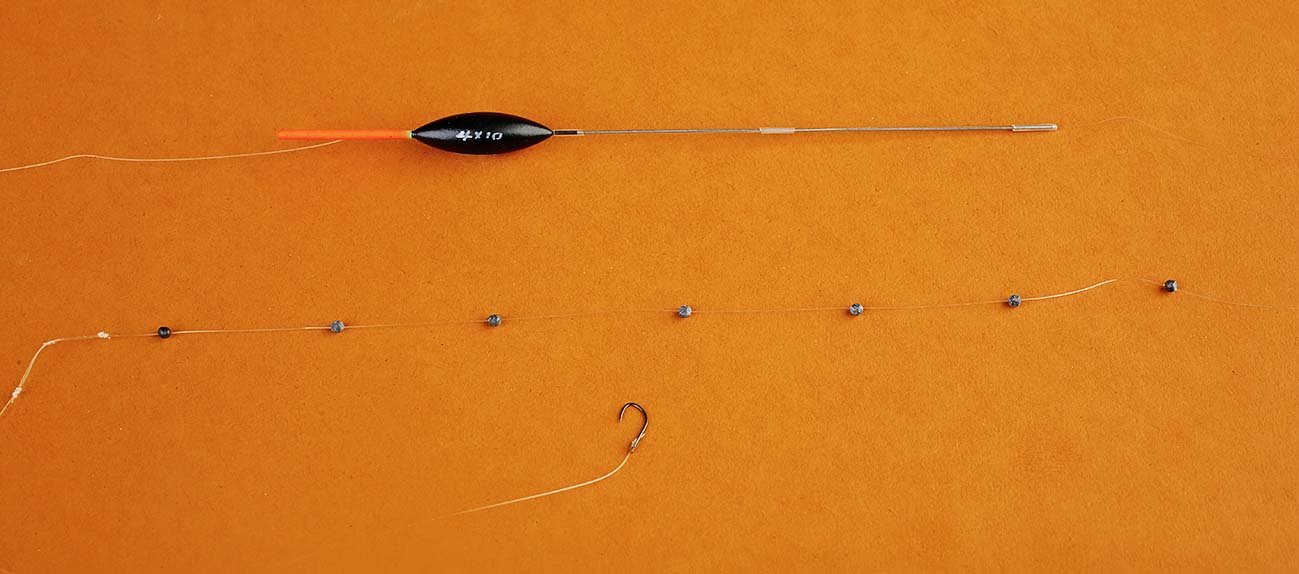Five amazing fishing rigs
Here are five amazing fishing rigs to help you catch more next time you are on the bank. Whether you fish with a pole or a rod these rig will keep you catching all day long and give you the best chance of perfectly presenting your bait. So here are five of the best fishing rigs with Steve Ringer.
Carp Ape
The KC Carpa Ape is a versatile float pattern that I use for lots of different options, ranging from shallow work to mud-line fishing against an island.
In autumn it comes into its own for fishing across in 18ins to 3ft of water on a snake lake.
Mainline: 0.15mm Guru N-Gauge
to a 4ins hooklength of 0.14mm Pure Fluorocarbon, which I really like at this time of year when the colour starts to drop out of venues – I’m convinced it gets me those extra bites.
Hook: Size 16 or 18 Guru F1 Pellet. These are perfect for pellets, corn and even maggots.
Shotting: Normally a tightly strung bulk of No10 shot. However, if the water is very clear I will string these out more to achieve a slower fall of the hookbait. Mix it up to find out what works best on the day.
Mick Wilkinson F1 Slim
I designed this float with Mick as I wanted a slim-bodied wire stemmed float with a relatively short bristle that sits quickly when lifting and dropping the rig.
Mainline: 0.13mm Guru N-Gauge to a 4ins hooklength of 0.10mm Pure Fluorocarbon. Fluoro gives me an edge once the water starts to clear.
Hook: Size 18 Guru F1 Pellet for maggot and pellet work. This fine-wire hook is spot on for F1 fishing and is easily s’ ’carp too.
Shotting: This depends on whether I am maggot or pellet fishing. For maggots I’ll always opt for a loosely strung bulk of No11 shot and for pellets a tightly strung bulk. My theory has always been that shy-biting F1s follow maggots down before sucking them in, so a slowly-falling hookbait is important.
This is backed up by the fact that when maggot fishing most bites come just as the float settles.
Pellets seem very different. I always feel a more positive shotting pattern works better.
Carpa Perfect/Gloucester
My favourite pattern for deep-water silver fish work, I use this for all my Irish work as well as winter pellet fishing for skimmers.
This float features a wire stem so is super-stable, plus it has a thick bristle, meaning it’s easily visible in even the poorest of conditions.
Float size depends on depth and conditions. As a guide, for deep-water skimmer fishing in fair conditions I will opt for 1.25g.
Mainline: 0.15mm Guru N-Gauge – quite heavy, but this helps to minimise tangles when shipping in and out at speed. Hooklength is 6ins of 0.12mm Pure Fluorocarbon. There is always the chance of a rogue carp, and this gives me a good chance of landing it.
Hook: Size 16 Guru F1 Pellet.
Shotting: Slightly different to the norm. In deep water I like to fish with positive droppers, so I use double No9s with the first pair 7ins from the hook and the next two 7ins above this. Then, a further 7ins-8ins further up, I have my olivette and shot.
Something I do on all my heavy rigs is fix a few small half-styls a few inches above my olivette. These allow me to fine tune the bristle of the float during the session.
Mick Wilkinson steady
If I had to pick one float to do the lot on commercials, then this would be it! There isn’t a single bait that I wouldn’t fish with it. Pellets, corn, meat and even maggots, the Steady is perfect for them all. It’s also a float I will use on both short and long pole where carp are concerned.
I’m a firm believer that light floats produce more bites once the water starts to clear. I’ll often use a 4x10 float in depths of 4ft-6ft, to give that all-important slow- falling hookbait that appears as natural as possible.
Mainline: For carp it’s 0.17mm Guru N-Gauge to a 6ins hooklength of 0.15mm in the same material.
Hook: Size 16 super LWG which
covers me for both meat and corn hookbaits, as well as maggots and pellets.
Shotting: Loosely strung bulk of No10s, with the bottom shot 6ins from the hook and the rest of the droppers spaced at 1.5ins-2ins intervals above this.
The idea is to get a slow and even fall of the hookbait – when carp fishing in the colder months most bites tend to come just as the float settles, indicating that the carp has spotted the hookbait and followed it down.
Running Feeder Rig
One question I get asked more than any other is how to tie my running feeder rig, which I now feel I have pretty much spot on in terms of knowing I’m always fishing tangle-free.
This is the rig I use for everything from the World Feeder Championships to Ireland. It can be used with or without a shockleader, and whether I use one or not really depends on the distance at which I am fishing.
1: Thread a link on to the line. The one in the picture is a prototype Guru link which is based on my own version. You’ll notice it’s covered in shrink tube, which eliminates any tangle-causing sharp edges or tags. I prefer a short link of 1.5ins.
2: Fix two No8 Stotz on the line.
3: Tie a 3ins twizzled loop below the Stotz.
4: Slide the Stotz down to the knot at the top of the 3ins twisted loop.
5: Tie a 1ins loop in the end of the 3ins twisted loop.
6: Attach your hooklength to this loop, loop-to-loop style.





